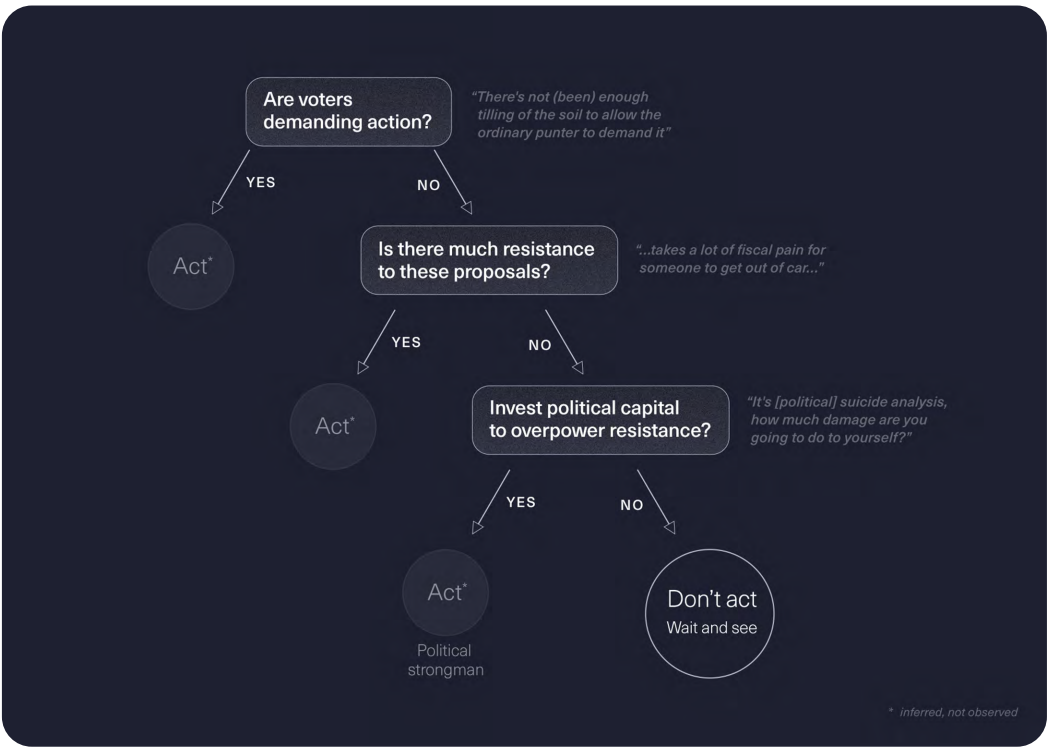
Strategy, Governance and Risk
The following article is republished from Sein with permission.
We like to think that big policy decisions are made thoughtfully, informed by data, with careful consideration of the facts and after a deliberate weighing of the options. Not so it seems.
It turns out that the political elite use ‘rules of thumb,’ also known as heuristics, to make the big decisions1. So who are these people, why do they decide that way, and is it OK that they do so?
The elite is a small group of individuals who occupy prominent positions in society, and who have preferential access to resources and an outsized impact on events. They tend to recognise one another, act and think alike. The political elite is a subset, comprised of politicians, senior bureaucrats, and advisers. Politicians in power face a 24/7 news cycle, deal with complex problems and divergent opinions. And though this is what they signed up for, it can lead to the political elite relying on heuristics to cope.
The literature shows that the political elite are prone to use heuristics such as, being more sensitive to losses than gains, also known as prospect theory, status quo bias, overconfidence – leading to poor decision-making, which when combined with escalation of commitment could help explain why once having made a poor decision, the elite are also prone to doubling down on previous commitments and stereotyping2 to name a few.
The issue is though—is that OK?
Is it good enough, for example, that a decision to go to war is influenced by heuristics, or should we expect a more thoughtful approach before placing troops in harm’s way?
There are two leading schools of thought around the use of heuristics. The heuristics and bias (H&B) school lead by the Nobel laurate Daniel Kahneman, and the fast and frugal (F&F) school led by Gerd Gigerenzer.
The H&B school argues that there are two styles of decision-making—either quick or deliberate8, however there are a few caveats. These decision-making styles could be thought of as being at opposite ends of a spectrum, and by implication, a blend of these two decision-making styles is likely, as is a sequencing of different decision-making styles, e.g. using heuristics to narrow down the range of choices, then a deliberate approach to choosing between them. But when it comes to political decision-making Kahneman argues that heuristics should not be used9, whereas Gigerenzer allows for their use in political decision-making10. So, which school is right? Unfortunately, it’s not that straightforward.
The problem with political decision-making is that often the answer to a question is unknown in advance, because the problems are complex. The lack of a “correct” answer makes testing alternatives impossible. To make matters worse, decision-making by the political elite make can be motivated by their desire to stay in office11. And so, it’s not possible to test motivated decision-making in an objective sense, because it is subjective—by definition.
Notwithstanding the impossibility of a binary solution to the debate about the use of heuristics in political decision-making, we wanted to learn more. So, we managed to secure rare access to 21 senior ex state politicians, their advisers, and senior former bureaucrats discussing an innovative but politically difficult transport pricing policy proposal.
Road congestion in large cities is a significant issue in Australia. Charges for road use are levied upfront (e.g. vehicle registration tax) and do not reflect actual road usage. An alternate approach to transport network pricing (TNP) would be a user pay system where those who travel during peak times, for greater distances or into highly congested zones would pay more than those who didn’t. And so, there was political risk.
There were 21 participants, six of whom were current or former senior politicians (from both major political parties), seven current or former senior bureaucrats (i.e. heads of departments), and eight current or former political advisers. Participants were drawn from the two major parties, for balance. And as the participants were no longer in positions of executive power, we hoped to minimise the risk of presentation management overlaying the decision-making process. An extensive briefing document was provided to all participants in advance, including a detailed business case, economic modelling, pricing recommendations, traffic projections and demographic analysis.
We found that the political elite used heuristics in two ways.
First, to decide whether to engage with an issue, using the “wait-and-see” heuristic. And second—having decided whether to engage—how to engage, using political empathy to guide their actions on TNP.

The primary concern of the elite we observed was not judging the TNP in isolation on its merits, rather whether they ought to engage with the TNP at all. In other words, they didn’t act as judges, considering the facts of each case brought before them. Instead, they behaved like investors, deciding which stock to invest in from a broad market.
So, the first question they asked was – are voters demanding action? They sensed that though there was dissatisfaction about traffic congestion, community sentiment hadn’t crystallised to the point where action was being demanded. The issue wasn’t making headlines, and so, the answer to the first question was “no”, the issue wasn’t urgent and didn’t demand action. This led to the second question; if this issues wasn’t urgent, yet they pressed ahead with implementing the TNP regardless – would there be much resistance?
In a telling comment, a senior politician summed up the situation, based on his experience of trying to change car usage behaviour through pricing signals alone:
“Pricing hasn’t worked. [It] takes a lot of fiscal pain for someone to get out of a car.”
Politicians representing outer suburbs feared community pushback from increased costs which cast a shadow of self-interest over their decision-making.
So, the calculation was – “yes”, there was a risk of strong resistance to those proposals from segments of the community. At this point they thought – the matter isn’t urgent, there’s likely to be pushback and so they asked the third key question – if we impose this policy against the wishes of the electorate…
“are we prepared to spend the political capital needed to overpower that resistance”
This strategy, characterised as the “political strong man” approach had been used in New York, London, and Singapore for example. A former adviser summarised the group’s dilemma at this point in the decision tree.
“It’s [political] suicide analysis, how much damage are you going to do to yourself?”
A former senior bureaucrat summed up the three step decision tree with a pointed question:
“Does any politician think that the big problem is congestion and that the answer is pricing?”
The matter was decided quickly with the answer to this question by a senior former politician:
“No. Not yet.”
To identify the heuristics voters might use to judge the proposal, the political elite used political empathy – putting themselves in voters’ shoes to identify which heuristics voters would use when judging a policy.
To help them with political empathy they used:
And so, the complex issue of whether to engage with the TNP was decided. It was a decision not to engage, or a decision to make no decision. A previously identified12 but not observed heuristic of “wait-and-see” was used to decide the fate of an innovative policy proposal.
While we identified seven factors that influence the use of heuristics by the political elite, we saw five in play at our forum – experience, context, issue complexity, and urgency. Though our forum members were highly experienced, they were not experts in transport pricing policy and so context was key. The matter was highly complex, and as there was no pressing need to decide, urgency was low. The combination of those factors influenced decision-making style, and caused them to use both styles of thinking, not either.
The politicians we observed made a decision about a decision, which could be considered deliberate decision-making based on elaborate thought, so supporting the F&F school. However, in arriving at that decision they did not consider the details of the extensive briefing materials, rather they used a three-step process to reach an acceptable answer quickly – the hallmark of heuristic decision-making, preferring to “wait-and-see”.
While it looks like an important question – is it OK for heuristics to be used for political decision-making, it turns out that this isn’t a good question after all. This forum showed that both styles of decision-making can be appropriate, rather than one or the other. And while most studies of political decision-making focus on decision-making, few address political non-decision-making. For the first time to our knowledge, we found evidence of the use of heuristics for avoiding a decision, and the shaping of public policy by inaction.
When dealing with political elite, there’s a real risk that there either won’t be a decision, or one that “doesn’t make sense”, so what can be done to avoid those poor outcomes?
In summary, there’s evidence that heuristics have their place in decision-making, and that a blend of deliberate thinking and heuristics is effective.
But the issue is not the theoretical one of whether important people ought not use heuristics, it’s the pragmatic one of how to cope with the fact that they do. The “wait-and-see” heuristic is alive and well among the political elite, understanding how to deal with it is key.
This article is based on an article published in the Australian Journal of Public Administration, the peer reviewed journal of the Institute of Public Administration Australia.
Our team of big thinkers will work closely with you to deeply understand your challenges and create lasting impact. For us that means building capability, doing work that's part of something bigger, and reflecting the best of what consulting can be to uplift organisations and the communities they serve.